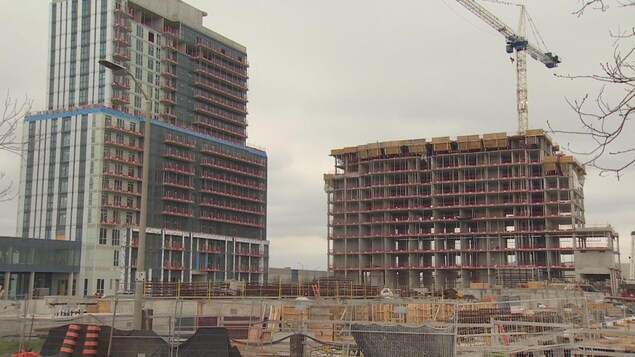The workers, members of section 183 of the Labourers’ International Union of North America [LiUNA, Syndicat des travailleurs internationaux de l’Amérique du Nord, traduction libre], work in six sectors of the residential construction industry. They rejected the latest proposals from business associations.
Basically it’s all about the money
Jason Ottey, director of government relations and communications for Local 183 of the LiUNA.
Among the strikers are tower formwork workers – who carry out concrete construction work on apartment buildings – self-leveling flooring workers, house framers and tile setters , ramps, carpets and hardwood.
Today we have a housing shortage and a severe shortage of people to build that housing.
said Mr. Ottey. Inflation has never been higher and Canadians across the country are dealing with the cost of living crisis we are facing. Our members too.
The union wants the province’s contractor associations to return to the bargaining table with a set of wage measures that reflect the work done during the COVID-19 pandemic and take into account inflation, the cost of living , in addition to providing for increases linked to inflation during the term of the contract under negotiation.
The strike affects workers in the Greater Toronto Area, Central Ontario, Southern Ontario and parts of Southwestern and Eastern Ontario.
Ottey said workers, deemed essential, continued to work throughout the COVID-19 pandemic as other sectors of the economy were shut down.
We didn’t ask for a raise due to the pandemic, we can’t work from home, and therefore we thought our management partners would show their appreciation in this round of bargaining. And they didn’t. They didn’t measure up
did he declare.
Collective agreements for 30 sectors or trades in the residential construction industry expired on Saturday.
Possible delays
According to Residential Construction Council of Ontario [RESCON, Conseil de la construction résidentielle de l’Ontario, traduction libre]approximately 20 sectors have reached an agreement and approximately four sectors are continuing negotiations, have gone to arbitration or have reached an agreement in principle and are awaiting a ratification vote.
We still hope that the parties can return to the table, or accept arbitration, or agree to resolve these disputes without long strikes. Then we can get back to building the homes everyone in Ontario needs.
said Andrew Pariser, vice president of RECON.
In an email Monday, Pariser said the impact of the strike will vary from project to project. Those in the framing or shaping of the towers will be more affected, he said.
Such a strike adds pressure on schedules, the supply chain and is very disruptive to the construction of the residential housing units we need to build for all Ontarians
according to him. The cost increase will vary from unit to unit depending on the stage of construction and the length of the delay.
The province hopes for an agreement
Under Ontario’s Labor Relations Act, strikes in the province’s residential construction sector can begin on May 1 every three years, but must end no later than June 15. Any outstanding dispute is then settled by arbitration.
A spokesperson for the Ontario Ministry of Labor said in a statement Monday that its mediators have been involved in discussions with both parties and are available to assist them at the bargaining table.
We encourage employers and unions to do everything possible to resolve their differences at the bargaining table. We are convinced that by working together, the parties can reach an agreement
the ministry said in its statement.
With information from The Canadian News
Reference-ici.radio-canada.ca
